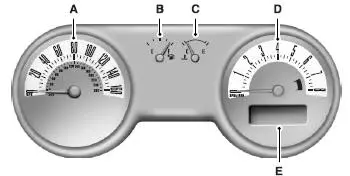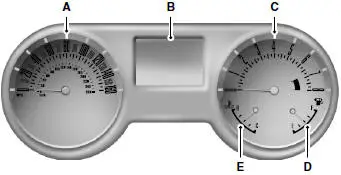Ford Mustang (2005-2014) Owners Manual: Gauges
Type 1

Cluster shown in standard measure. Metric similar.
A. Speedometer
B. Fuel gauge
C. Engine coolant temperature gauge
D. Tachometer
E. Information display. See Information displays for more information.
Fuel Gauge
Indicates approximately how much fuel is left in the fuel tank (when the ignition is on). The fuel gauge may vary slightly when the vehicle is in motion or on a grade. The fuel icon and arrow indicates which side of the vehicle the fuel filler door is located.
Engine Coolant Temperature Gauge
Indicates engine coolant temperature. At normal operating temperature, the level indicator will be in the normal range. If the engine coolant temperature exceeds the normal range, stop the vehicle as soon as safely possible, switch off the engine and let the engine cool.
WARNING: Never remove the coolant reservoir cap while the engine is running or hot.
Type 2

Cluster shown in standard measure. Metric similar.
A. Speedometer
B. Information display. See the Information Displays chapter for more
information.
C. Tachometer
D. Fuel gauge
E. Engine coolant temperature gauge
Note: The instrument cluster gauges are backlit with white backlighting when the headlamps are off. When the headlamps are on, you can select one of the preset colors for the nighttime gauge backlighting or create up to three custom colors using the MyColor® feature (if equipped).
Ambient color and halo color are also selectable. See the Information Displays chapter for more information. When certain gauges enter a warning state, they will be backlit in red.
Fuel Gauge
Indicates approximately how much fuel is left in the fuel tank (when the ignition is on). The fuel gauge may vary slightly when the vehicle is in motion or on a grade. The fuel icon and arrow indicates which side of the vehicle the fuel filler door is located.
Engine Coolant Temperature Gauge
Indicates engine coolant temperature. At normal operating temperature, the level indicator will be in the normal range. If the engine coolant temperature exceeds the normal range, stop the vehicle as soon as safely possible, switch off the engine and let the engine cool.
WARNING: Never remove the coolant reservoir cap while the engine is running or hot.
 Warning lamps and indicators
Warning lamps and indicators
These indicators can alert you to a vehicle condition that may become
serious enough to cause expensive repairs. Many lights will illuminate
when you start your vehicle to make sure they work. If any ...
Other materials:
Removal
WARNING: The restraints control module (RCM) orientation is critical
for proper system
operation. If a vehicle equipped with an air bag supplemental restraint system
(SRS) has been
involved in a collision in which the center tunnel area has been damaged,
in ...
Engine (Disassembly)
Special Tool(s)
Service Set, Camshaft
303-017 (T65L-6250-A)
Remover, Crankshaft Vibration
Damper
303-009 (T58P-6316-D)
Lifting Bracket Set, Engine
303-D095 (D94L-6001-A) or
equivalent
Remover, Power Stee ...
Camshaft End Play - Push Rod Engines
Special Tool(s)
Dial Indicator Gauge with
Holding Fixture
100-002 (TOOL-4201-C) or
equivalent
1. Remove the valve tappets. Refer to the appropriate section in Group 303
for the procedure.
2. Use a Dial Indicator Gauge with Holding Fixture ...

